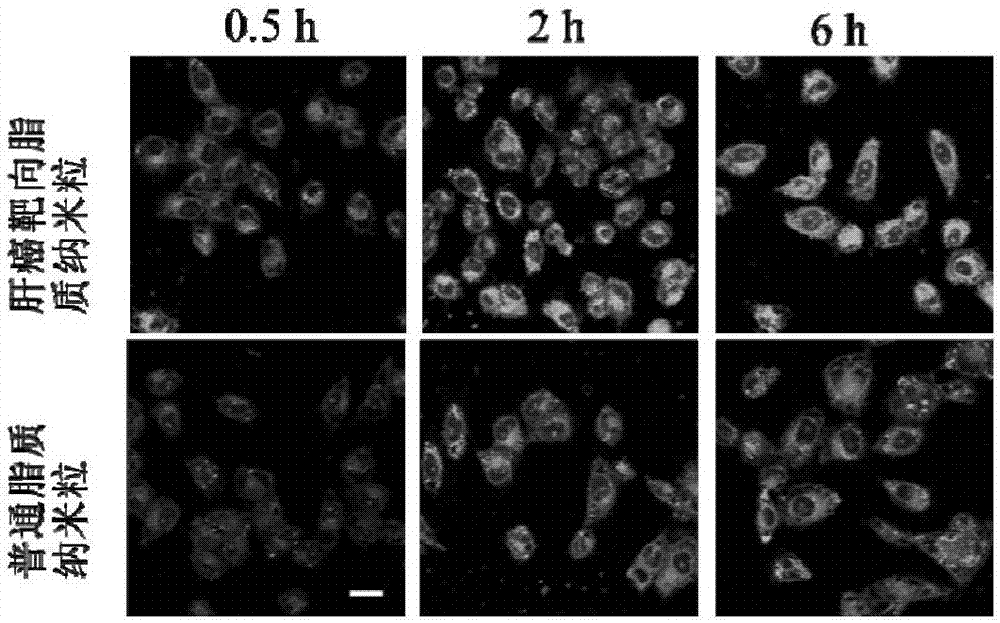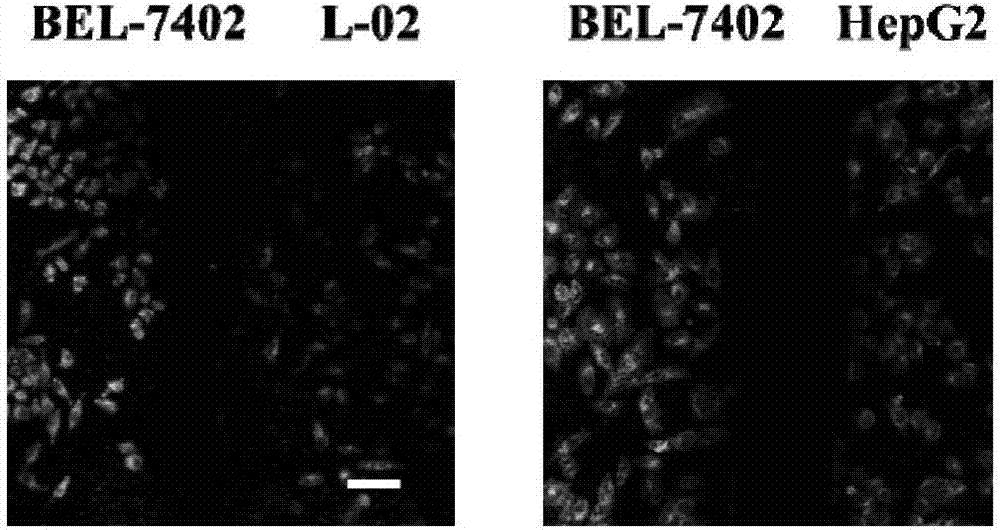Hepatocarcinoma targeting lipid nanoparticle as well as preparation method and application
A technology for targeting lipids and nanoparticles, which can be used in pharmaceutical formulations, medical preparations with non-active ingredients, and medical preparations containing active ingredients, etc. It can solve problems such as restrictive design, achieve strong lipophilicity and enhance drug efficacy. Effect
- Summary
- Abstract
- Description
- Claims
- Application Information
AI Technical Summary
Problems solved by technology
Method used
Image
Examples
Embodiment 1
[0019] Take 10 mg of A54 polypeptide, accurately weigh it, dissolve it in 0.5 mL of anhydrous dimethyl sulfoxide, and prepare a solution with a concentration of 20 mg / mL. Add 4 μL of di-tert-butyl dicarbonate reagent to the A54 polypeptide solution, stir magnetically (300 rpm), and react for 12 hours at room temperature in the dark. Add 5 mg of carbodiimide and 3 mg of N-hydroxysuccinimide, and stir at room temperature for 1.5 h to obtain reaction solution 1. Another 17.6 mg of polyethylene glycol containing amino groups at both ends was taken, accurately weighed, and dissolved in 200 μL of anhydrous dimethyl sulfoxide. The reaction liquid 1 was added dropwise to the polyethylene glycol solution, and the reaction was stirred at room temperature for 12 h. Add 3 mg of N,N-disuccinimidyl carbonate, and stir at room temperature for 9 hours to obtain reaction solution 2. Take 2.36 mg of stearylamine, accurately weigh it, and ultrasonically dissolve it in 300 μL of absolute ethano...
Embodiment 2
[0021] Take 10 mg of A54 polypeptide, accurately weigh it, dissolve it in 0.5 mL of anhydrous dimethyl sulfoxide, and prepare a solution with a concentration of 20 mg / mL. Add 6 μL di-tert-butyl dicarbonate reagent to the A54 polypeptide solution, stir magnetically (300 rpm), and react at room temperature in the dark for 12 hours. Add 5 mg of carbodiimide and 3 mg of N-hydroxysuccinimide, and stir at room temperature for 1.5 h to obtain reaction solution 1. Another 17.6 mg of polyethylene glycol containing amino groups at both ends was taken, accurately weighed, and dissolved in 200 μL of anhydrous dimethyl sulfoxide. The reaction liquid 1 was added dropwise to the polyethylene glycol solution, and the reaction was stirred at room temperature for 12 h. Add 3 mg of N,N-disuccinimidyl carbonate, and stir at room temperature for 9 hours to obtain reaction solution 2. Take 2.36 mg of stearylamine, accurately weigh it, and ultrasonically dissolve it in 300 μL of absolute ethanol i...
Embodiment 3
[0023] Take 10 mg of A54 polypeptide, accurately weigh it, dissolve it in 0.5 mL of anhydrous dimethyl sulfoxide, and prepare a solution with a concentration of 20 mg / mL. Add 6 μL di-tert-butyl dicarbonate reagent to the A54 polypeptide solution, stir magnetically (300 rpm), and react at room temperature in the dark for 12 hours. Add 6 mg of carbodiimide and 3.6 mg of N-hydroxysuccinimide, and stir at room temperature for 1.5 h to obtain reaction solution 1. Another 17.6 mg of polyethylene glycol containing amino groups at both ends was taken, accurately weighed, and dissolved in 200 μL of anhydrous dimethyl sulfoxide. The reaction liquid 1 was added dropwise to the polyethylene glycol solution, and the reaction was stirred at room temperature for 12 h. Add 3 mg of N,N-disuccinimidyl carbonate, and stir at room temperature for 9 hours to obtain reaction solution 2. Take 2.36 mg of stearylamine, accurately weigh it, and ultrasonically dissolve it in 300 μL of absolute ethanol...
PUM
| Property | Measurement | Unit |
|---|---|---|
| particle diameter | aaaaa | aaaaa |
| particle diameter | aaaaa | aaaaa |
| particle diameter | aaaaa | aaaaa |
Abstract
Description
Claims
Application Information
 Login to View More
Login to View More - R&D
- Intellectual Property
- Life Sciences
- Materials
- Tech Scout
- Unparalleled Data Quality
- Higher Quality Content
- 60% Fewer Hallucinations
Browse by: Latest US Patents, China's latest patents, Technical Efficacy Thesaurus, Application Domain, Technology Topic, Popular Technical Reports.
© 2025 PatSnap. All rights reserved.Legal|Privacy policy|Modern Slavery Act Transparency Statement|Sitemap|About US| Contact US: help@patsnap.com



